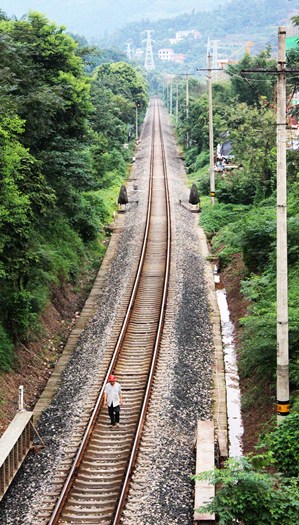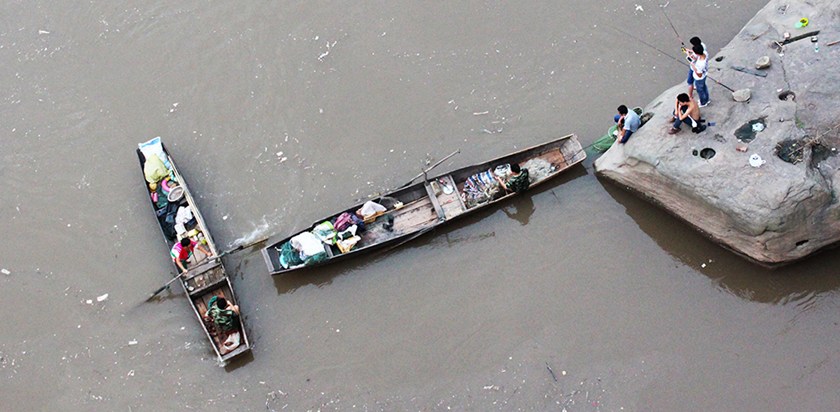YIBIN, CHINA - I find myself captivated by this city of 4.5 million people that’s nestled in the heart of southern Sichuan province. Yibin is the first city along the mighty Yangtze River at the confluence of the Min River, which adds its flow to the longest river in Asia.
The city is also home to the Wuliangye Yibin Company, the government-owned producer of a fragrant (and potent) rice liquor.
Much of my half week in the city has been spent driving to nearby tourist destinations, an activity excellent for sightseeing, but not so good for those with a distaste for cramped spaces.
My legs are antsy and my eyes are scanning as we drive the spit of smooth highway winding alongside the Yangtze, some 60 kilometres outside Yibin.
That’s when we pass a place that captures my imagination, a spot just outside Yibin proper, at a fork in the road where you can go left towards Lizhuang Ancient Town, or right to the Bamboo Sea, one of China’s national scenic spots.
What’s so fascinating to me is the view off Nunguang Bridge, a spectacular vista of Yangtze waterfront and the industrial skyline. Off the other side of the bridge I see an older part of Yibin — weathered stone homes stacked in blocks with stone gabled rooftops. It’s not colourful, but it is compelling.
Every chance I get I press my face against the bus window for a fleeting view of the area.
Later, after disembarking the tour bus, I make my way back from downtown Yibin to explore this intriguing part of the city. I take photos of the street signs as I retrace the bus route, intending them to serve as my digital breadcrumbs.
However, I quickly sway off path.
I had mentally mapped my route while looking down at the city from my hotel window. I needed to head south and then west towards the lush green mountainside.
This isn’t the first time I’ve done something like this. In my mind, scenic drives cannot compare to the not-always-scenic walkabout. Walkabouts are how I get to know a new city. I simply set off with the intent to stroll until I find something worth strolling to.
On this day, I pass first through a street south of the hotel. It’s not a commercial area, and there aren’t as many storefronts as there are street food vendors with cheap plastic furniture arranged beneath vinyl coverings.
Soon I’m on a major road with rush-hour traffic racing past me in both directions. It’s not the prettiest place, but there are photo opportunities along the way: houses perched on terraces, artsy apartment blocks and old men walking along the train tracks that cuts through Yibin.

Above: Rail tracks used as a road.
I check my watch – this is taking a bit longer than expected. It seems I may have overestimated the proximity of this scenic spot.
I’ve been walking for an hour, though, and I’m certainly not going to stop now. I’m going at my regular clip and the bend ahead looks familiar.
Yes, I recognize this place. It’s the thicket of construction just before the road takes a turn down onto the dragon’s back ridges of the Yangtze River. The route looks a little more treacherous now that I’m on foot.
I calculate the risks and march forward. With motorcycles, taxis and large bucket trucks charging to my left, I proceed with wary enthusiasm. There is a liberal amount of honking.
I round the corner and there it is: Nunguang Bridge.
I see the collection of stacked home — they’re peeling and dark. Just past where they sit is a narrow stone bridge crossing the river. It reminds me of an old aqueduct I once saw in the United Kingdom, essential and ancient.
This is the China that is fading into the ultra-modern and urban.
I look down on the murky Yangtze — its water is chocolate brown and scattered with bobbing trash. There’s a beauty about it, though, and I lean over the bridge to watch two fishing boats rendezvous below me.
With the passing of every large truck, the bridge rumbles and shakes. I twist my camera band tighter around my wrist.
I start taking photos, but there’s one problem — the lighting isn’t ideal and I’m having a hard time finding a focal point for my shots. I can’t quite capture the ethereal nature of the bridge, and so I cross to the other side of the road, disappointed with what I’ve found — factory buildings dotting the river. The cables of the bridge gleam in the end-of-day light. A group of kids runs over and they beg me to take their photo as they show off their scooter skills and karate moves.


Left: Fisherman cast for their daily catch on the murky river. Right: Local kids ham it up for the camera.
The photo set ends up being my favourite from my two-week trip. I feel as though I saw a glimpse of the real Yibin — one of traffic and playtime, less-travelled roads and Yangtze industry.
I head back to the hotel, this time by taxi. The afternoon leg stretch I so desired has been accomplished.
If there is any lesson I can hope to instill in travellers, it is this: when aiming to get a certain photo or memory, remember it’s not just about the final destination, but about the journey getting there. What you find may not be what you were expecting, but take it in stride and often you’ll find something just as beautiful. A metaphor for life, and an excuse for an afternoon stroll.
About the Author
Hilary's love of travel started as a child, when she and her family would visit relatives in Ireland every second summer. Today, she's been fortunate to travel across North America, Europe, and Asia. Hilary has a journalism degree from Carleton University, and worked as an award-winning reporter with CBC Radio in Sudbury. In addition to her love of telling stories, Hilary thrives in the outdoors, and can frequently be found cross country skiing in Gatineau, hiking in parks across Ontario, and biking (in both the summer and winter). She loves writing about adventures in her own backyard and beyond.